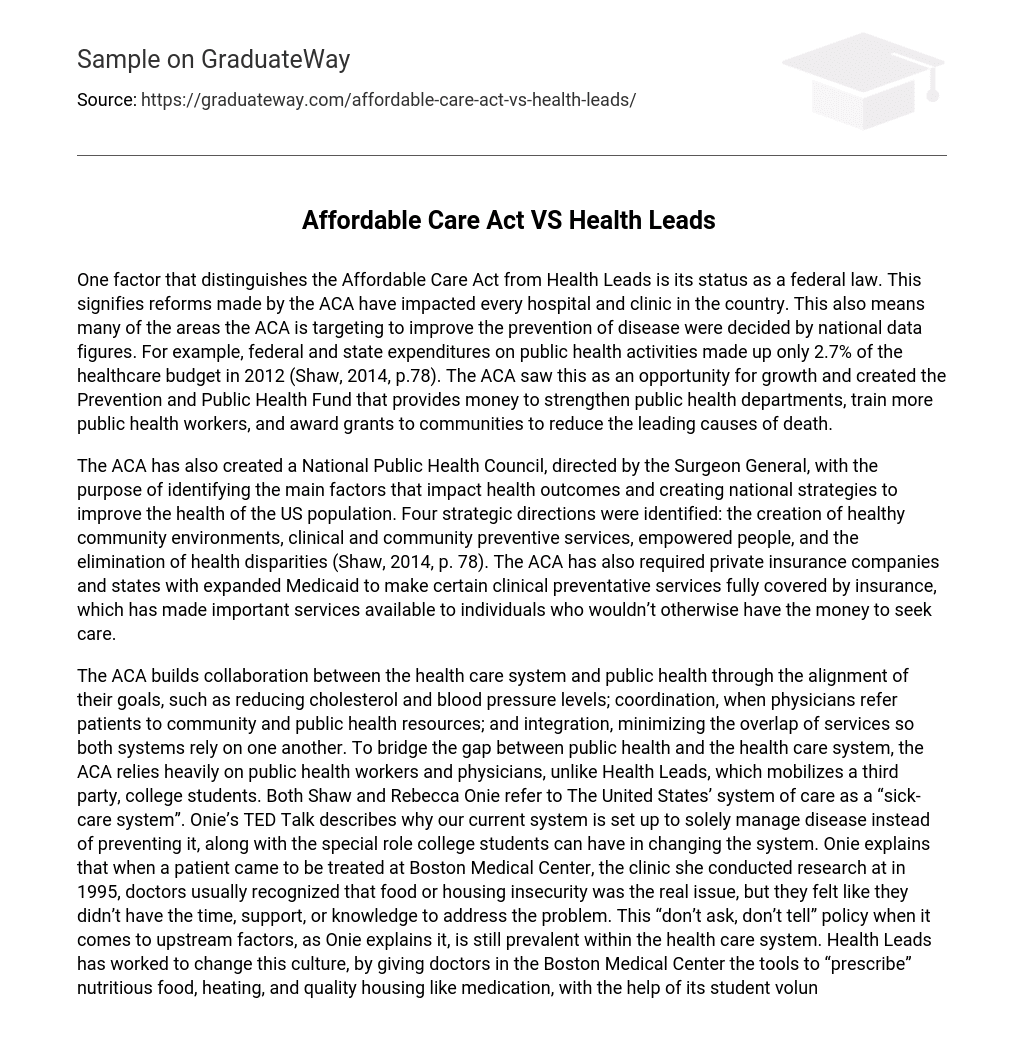One factor that distinguishes the Affordable Care Act from Health Leads is its status as a federal law. This signifies reforms made by the ACA have impacted every hospital and clinic in the country. This also means many of the areas the ACA is targeting to improve the prevention of disease were decided by national data figures. For example, federal and state expenditures on public health activities made up only 2.7% of the healthcare budget in 2012 (Shaw, 2014, p.78). The ACA saw this as an opportunity for growth and created the Prevention and Public Health Fund that provides money to strengthen public health departments, train more public health workers, and award grants to communities to reduce the leading causes of death.
The ACA has also created a National Public Health Council, directed by the Surgeon General, with the purpose of identifying the main factors that impact health outcomes and creating national strategies to improve the health of the US population. Four strategic directions were identified: the creation of healthy community environments, clinical and community preventive services, empowered people, and the elimination of health disparities (Shaw, 2014, p. 78). The ACA has also required private insurance companies and states with expanded Medicaid to make certain clinical preventative services fully covered by insurance, which has made important services available to individuals who wouldn’t otherwise have the money to seek care.
The ACA builds collaboration between the health care system and public health through the alignment of their goals, such as reducing cholesterol and blood pressure levels; coordination, when physicians refer patients to community and public health resources; and integration, minimizing the overlap of services so both systems rely on one another. To bridge the gap between public health and the health care system, the ACA relies heavily on public health workers and physicians, unlike Health Leads, which mobilizes a third party, college students. Both Shaw and Rebecca Onie refer to The United States’ system of care as a “sick-care system”. Onie’s TED Talk describes why our current system is set up to solely manage disease instead of preventing it, along with the special role college students can have in changing the system. Onie explains that when a patient came to be treated at Boston Medical Center, the clinic she conducted research at in 1995, doctors usually recognized that food or housing insecurity was the real issue, but they felt like they didn’t have the time, support, or knowledge to address the problem. This “don’t ask, don’t tell” policy when it comes to upstream factors, as Onie explains it, is still prevalent within the health care system. Health Leads has worked to change this culture, by giving doctors in the Boston Medical Center the tools to “prescribe” nutritious food, heating, and quality housing like medication, with the help of its student volunteers. Unlike the practices set up by the ACA, patients connected to Health Leads are able to get connected to community and public health resources in the waiting room of their clinic.
Onie also has a legal background, so her prevention methods are slightly different than the ACA. Health Leads has more of a focus on environmental issues, like poor quality housing, whereas the ACA provides funding to resources like smoking cessation programs. After watching Onie’s TED Talk, I realized the confidence of healthcare workers have in addressing upstream factors greatly affects the quality of care received. In her TED Talk Onie quotes Mia Lozada, a former Health Leads volunteer, “When my classmates write a prescription, they think their work is done. When I write a prescription, I think, can the family read the prescription? Can they get to the pharmacy? …these are the questions I learned in Health Leads, not in medical school”.
Volunteering for an organization like Health Leads allows future leaders to fully realize the impact of upstream factors, and recognize they have an obligation to address them as licensed practitioners. Together, the ACA and Health Leads demonstrate that with significant changes in policy and a strong, motivated public health workforce, US healthcare can shift from a system focused on treatment to one that prioritizes prevention.





